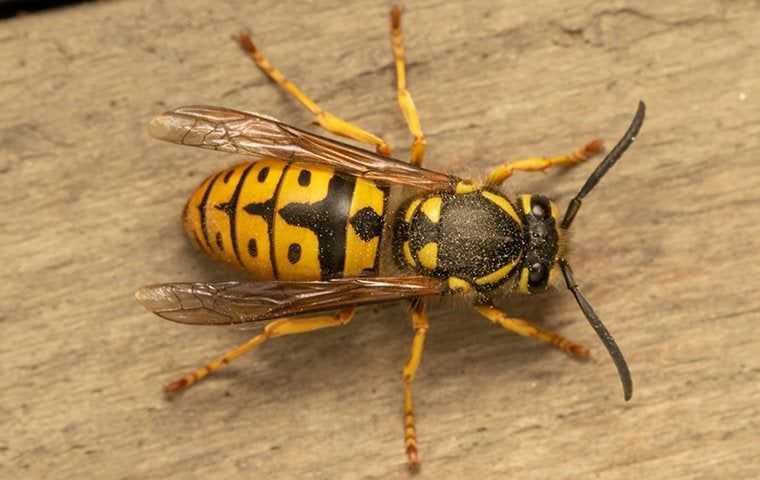Yellow Jacket Identification Guide
What are yellow jackets?
Yellow jackets are a type of social wasp. They primarily feed on other insects, which makes them beneficial, helping to control populations of nuisance and potentially dangerous insects. They are also responsible for some pollination, but not as much as bees and other species.
Stinging insects can look very similar to each other. Yellow jackets are identified by their abdomen that has alternating black and yellow stripes. Their body is sleek and shiny, and they have a very defined "waist" that connects the abdomen to the thorax.
A yellow jacket nest is placed either in the ground or aerially, depending on the species. They make their nests from a paper-like material they create with saliva and pieces of bark, wood, and other plant material. A yellow jacket nest has open cells throughout. Each nest may contain between 500 and 15,000 cells where the queen lays their eggs.

Are yellow jackets dangerous?
Yellow jackets are quite defensive and so having a nest of them on your property is quite problematic and poses a significant danger. Their ground nests can be incredibly hard to spot, and when you walk too close to one, it is common for them to lash out and deliver painful stings. In those allergic to their venom, a severe reaction may occur that can be life-threatening and require immediate medical attention. Yellow jackets are social and will attack as a group, with each one delivering multiple stings.
Why do I have a yellow jacket problem?
It takes a lot of food to feed the many members of a yellow jacket colony. Yellow jackets want to build their nests in a space that provides safe shelter and plenty of food for the workers to gather each day. The queen is the only member of a yellow jacket colony to survive the winter. In the spring, she will emerge from her winter hiding spot and find a suitable place to begin building a nest.
Often our yards and homes provide the perfect spot for a queen to place a nest. Our gardens offer plenty of insects for them to feed on, and things like trash cans, recycling bins, and outdoor eating areas provide lots of places for them to forage for sweets and meats. Yellow jackets will feed on many of the same foods we eat.
Where will I find yellow jackets?
Yellow jackets become active in the spring and remain active well into the fall. You'll often see these insects flying around our yard foraging for food.
Yellow jackets will place their nests in a variety of places. Some species prefer to nest in the ground, either in natural ground holes or in the abandoned nests of rodents and other small animals. Vibrations caused by doing things like routine yard work, walking or playing will agitate the yellow jackets and cause them to swarm in a defensive mode, stinging anything or anyone around they view as a threat.
Those species that like to build their nests up off of the ground place them in a variety of areas, including:
- Wall voids, attics, and chimneys
- Roof eaves and doorways
- Bushes and shrubs
- Tree hollows or tree stumps
How do I get rid of yellow jackets?
At TNT Home & Commercial Services, we offer a professional solution that will rid your Greater Cypress area property of yellow jackets and stop them from returning. We are proud to be a one-stop-shop for all your pest control needs!
Our focus is customer satisfaction and ensuring our customer's safety. We will work closely with you to eliminate dangerous yellow jackets and other pests from your home or business. If you would like to learn more about our yellow jacket control solutions, call TNT Home & Commercial Services today.
How can I prevent yellow jackets in the future?
More than an inconvenience, pests can be dangerous and cause a lot of damage. In addition to our professional home pest control and commercial pest control services, use the following tips to keep yellow jackets out of your yard and home:
- Remove garbage from your property regularly and make sure that garbage and recycling bins have tight-fitting lids and are placed away from the outside of your home.
- If there is a particular flowering plant, shrub, or bush on your property that yellow jackets swarm around, consider removing it.
- Fill in ground holes that have developed in your lawn.
- If you own fruit trees regularly, harvest the fruit and pick up any that have fallen to the ground.
- Inspect your home's exterior and seal any spaces you discover to keep these pests out of your house.
- Remove sources of water by keeping gutters clear, fixing dripping hoses, and repairing leaking outdoor fixtures.

